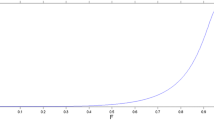Abstract
We developed three algorithms to facilitate an analysis of the parameter combinations (PASS points) that fit experimental data to a desired degree of accuracy. The clustering algorithm separates PASS points into clusters (PASS clusters) as a preliminary step for the following geometrical parametric analyses. The PASS region reconstruction algorithm defines the space of a PASS cluster to allow further parametric structural analysis. The feasible parameter space expansion algorithm produces a complete PASS cluster to be used for model predictions to evaluate the effects of variability and uncertainty. These algorithms are demonstrated using two pharmacokinetic models; a single compartment model for procainamide and a three-compartment physiologically based model for benzene. We found a more thorough representation of the parameter space than previously considered. Thus, we obtained model predictions that describe better the variability in population responses. In addition, we also parametrically identified a subpopulation that may have a higher risk for cancer.
Similar content being viewed by others
References
Auslander, D.M.; Spear, R.C.; Young, G.E. A simulation based approach to the design of control systems with uncertain parameters. ASME J. Dynamic Syst. Measurement, Control 104:20–26; 1982.
Bois, F.B.; Woodruff, T.J.; Spear, R.C. Comparison of three physiologically based pharmacokinetic models of benzene disposition. Toxicol. Appl. Pharmacol. 110:79–88; 1991.
Bois, F.B.; Paxman, D. An analysis of exposure rate effects for benzene using a physiologically based pharmacokinetic model. Reg. Toxicol. Appl. Pharmacol. 15:122–136; 1992.
Edward, A.W.F. Likelihood. London: Cambridge University Press; 1972.
Kalbfleisch, J.G. Probability and statistical inference, vol 2. New York: Springer-Verlag; 1985.
Koch-Weser, J. Pharmacokinetics of procainamide in man. Ann. NY Acad. Sci. 179:370–382; 1971.
Malkinson, A.M. Genetic studies on lung tumor susceptibility and histogenesis in mice. Environ. Health Perspect. 93:149–159; 1991.
Milanese, J. Estimation theory and prediction in the presence of unknown but bounded uncertainty: a survey. In: Milanese, J.; Tempo, R.; Vicino, A., eds., Robustness in identification and control. New York: Plenum; 1989.
Milanese, M.; Vicino, A. Estimation theory for nonlinear models and set membership uncertainty. Automatica 27:1991.
Press, W.H.; Flannery, B.C.; Teukolsky, S.A.; Vetterling, W.T. Numerical Recipes in C. Cambridge: Cambridge University Press; 1988.
Rickert, D.E.; Baker, T.S.; Bus, J.S.; Barrow, C.S.; Irons, R.D. Benzene disposition in the rat after exposure by inhalation. Toxicol. Appl. Pharmacol. 49:417–423; 1979.
Sabourin, P.J.; Chen, B.T.; Lucier, G.; Birnbaum, L.S.; Fisher, E.; Henderson, R.F. Effect of dose on the absorption and excretion of [14C] benzene administered orally or by inhalation in rats and mice. Toxicol. Appl. Pharmacol. 87:325–336; 1987.
Sabourin, P.J.; Bechtold, W.E.; Birnbaum, L.S.; Lucier, G.; Henderson, R.F. Differences in the metabolism and disposition of inhaled [3H] benzene by F344/N rats and B6C3F1 mice. Toxicol. Appl. Pharmacol. 94:128–140; 1988.
Shen, F.; Lee M.K.; Gong, H.; Cai, X.; King, M. Complex segregation analysis of primary hepatocellular carcinoma in Chinese families: interaction of inherited susceptibility and hepatitis B viral infection. Am. J. Hum. Genet. 49:88–93; 1991.
Spear, R.C.; Hornberger, G.M. Eutrophication in peer inlet-II: identification of critical uncertainty via generalized sensitivity analysis. Water Res. 14:443–449; 1980.
Spear, R.C.; Bois, F.Y.; Woodruff, T.; Auslander, D.M.; Parker, J.; Selvin, S. Modelling benzene pharmacokinetics across three sets of animal data: parametric sensitivity and risk implications. Risk Anal. 11:641–654; 1990.
Taylor, J.A. Epidemiologic evidence of genetic susceptibility to cancer. In: Spatz, L.; Bloom, A.D.; Paul, N.W., eds. Detection of cancer predisposition: laboratory approaches. New York: The March of Dimes Birth Defects Foundation; 1990; pp. 113–127.
Tiwari, J.L.; Hobbie, J.E. Random differential equations as models of ecosystems: Monte Carlo simulation approach. Math. Biosci. 28:25–44; 1976.
Tiwari, J.L.; Hobbie, J.E. Random differential equations as models of ecosystems—II. Initial conditions and parameter specification in terms of maximum entropy distributions. Math. Biosci. 31:37–53; 1976.
Tiwari, J.L.; Hobbie, J.E. Random differential equations as models of ecoystems—III. Bayesian inference for parameters. Math. Biosci. 38:247–258; 1978.
Tsai, K.C.Q.; Auslander, D.M. A statistical methodology of designing controllers for minimum sensitivity of parameter variations. ASME J. Dynamic Syst. Measurement Control 110:126–133; 1988.
Vicino, A.; Milanese, M. Optimal inner bounds of feasible parameter set in linear estimation with bounded noise. IEEE Trans. Auto. Control 36:759–763; 1991.
Walter, E.; Piet-Iahanier, H. Robust linear and nonlinear parameter estimation in the bounded-error context. In: Milanese, M.; Tempo, R.; Vicino, A., eds. Robustness in identification and control. New York; Plenum; 1989.
Woodruff, T.J. Parameterization and structure of benzene pharmacokinetic models. Ph.D. Thesis; Bioengineering Program. University of California, Berkeley, CA, 1991.
Woodruff, T.J.; Bois, F.Y.; Auslander, D.M.; Spear, R.C. Structure and parameterization of pharmacokinetic models: their impact on model predictions. Risk Anal. 12:189–201; 1992.
Young, G.E.; Auslander, D.M. A design methodology for nonlinear systems containing parameter uncertainty. ASME J. Dynamic Syst. Measurement Control 106:15–20; 1984.
Author information
Authors and Affiliations
Rights and permissions
About this article
Cite this article
Li, H., Watanabe, K., Auslander, D. et al. Model parameter estimation and analysis: Understanding parametric structure. Ann Biomed Eng 22, 97–111 (1994). https://doi.org/10.1007/BF02368226
Received:
Revised:
Accepted:
Issue Date:
DOI: https://doi.org/10.1007/BF02368226




